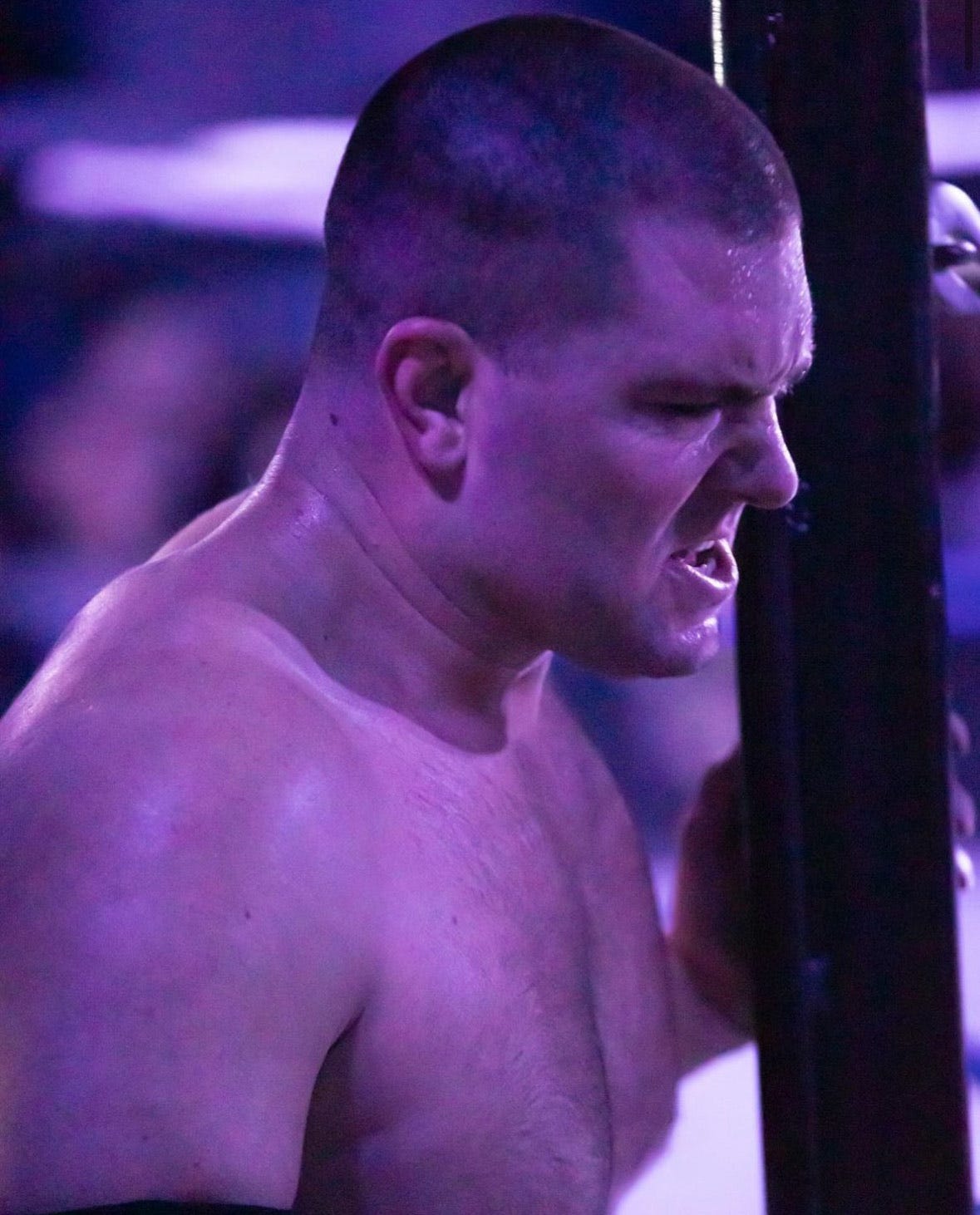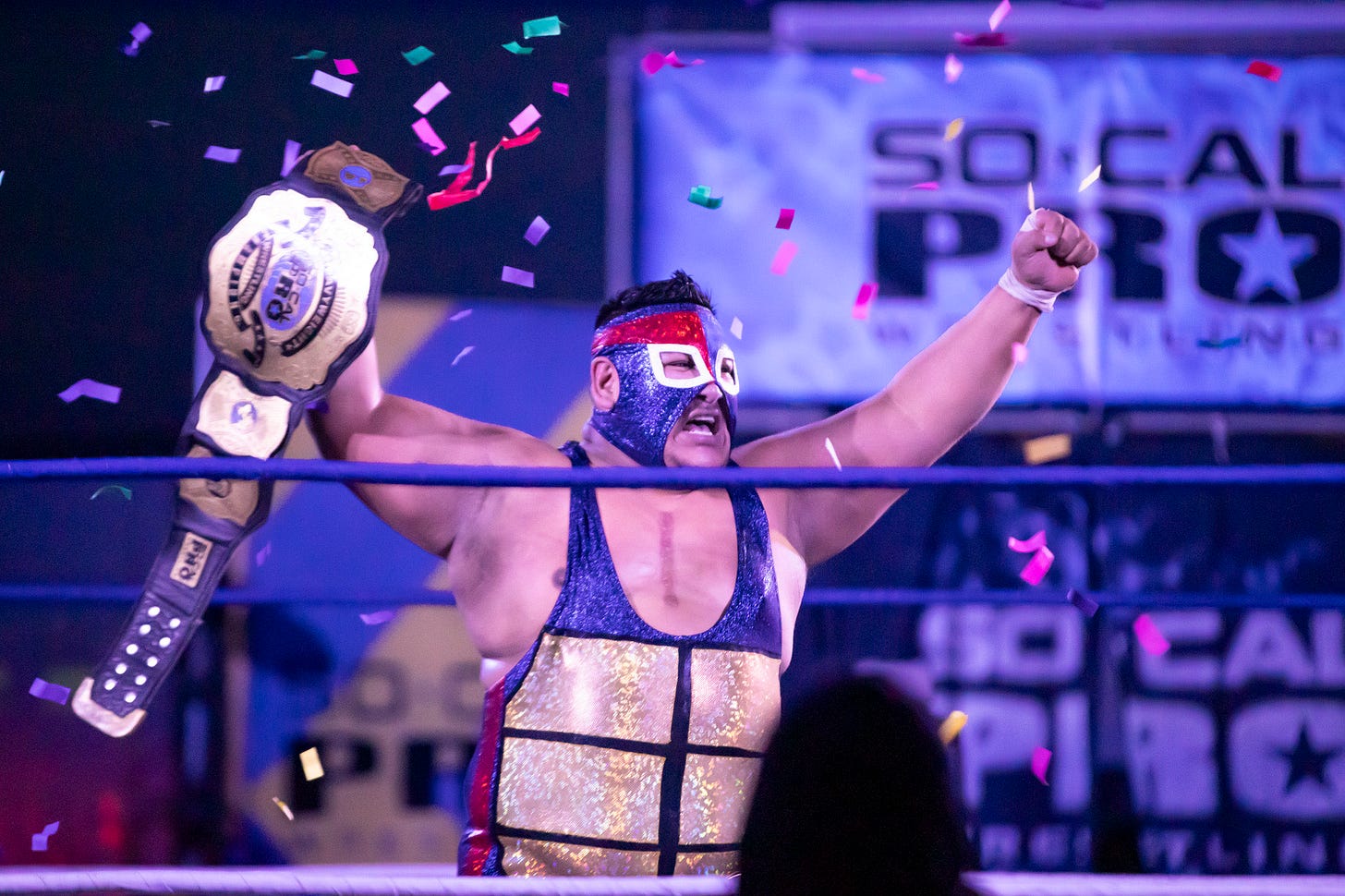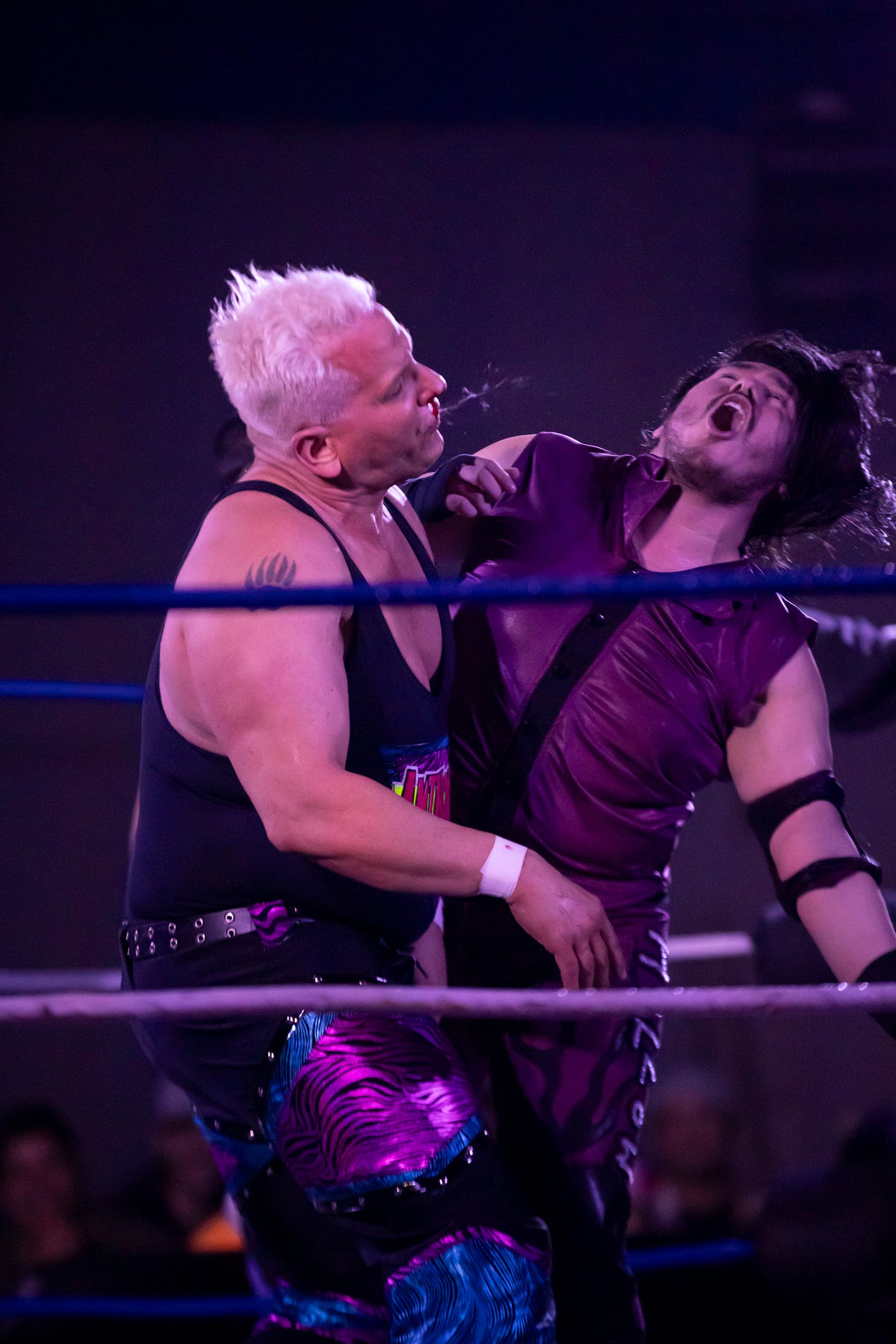The Eternal Sunshine of a Spotless Pro Wrestling Ring
A wrestling newbie discovers the joy in watching two men fight
At 7 p.m. on Jan. 13, 2024, the bell rang to announce the beginning of the first pro wrestling match I had ever attended: SoCal Pro Wrestling’s New Year’s Retribution. It took me all of 30 minutes to decide it wouldn’t be my last, but whether I—an Italian writer in her 30s—was the target audience of a wrestling match or not remained a mystery well into the performance.
Growing up, I was not exactly a wrestling aficionado. In fact, when I attended that first pro match at the Boys and Girls Club of Vista, Calif., the WWE feuds of my childhood all meshed together in a blurry memory of endless, Neapolitan summer afternoons packed with Hulk Hogan and Dwayne Johnson and The Undertaker competing for I didn’t really know what.
Still, what I remembered catching my attention as a kid—the loud cheering, the costumes, the acrobatics, and, of course, the endless fight of good versus evil—kept my eyes glued to the ring all the same, decades later, on a rainy Saturday evening.
At the entrance of the venue, the showrunners from SoCal Pro Wrestling, a training facility in San Marcos, greeted me with a thank you for taking an interest in their event. The room was packed with adults and children alike, couples on dates and groups of loud dudes evidently looking for some innocent weekend fun.
A few wrestlers could be found taking pictures with fans before the beginning of the event. People were munching, drinking, cheering and booing. Everybody was having the time of their life, and whether I was the target audience of this, or any other wrestling match, quickly lost importance.
A wrestling match has no specific target audience. The art form appeals to the masses because it elicits emotions that belong to the lived experience of every human. In being a universal cathartic experience, wrestling doesn’t discriminate based on age, gender or cultural background.
“Wrestling provides catharsis in the same way a powerful song or movie might do,” Psychology expert and author Dr. Billy San Juan tells me. “We relate strongly to a character, and we start to emotionally invest in that character. A good example is the legendary Dusty Rhodes, whose gimmick of a blue-collar worker resonated with the primary socioeconomic demographic of his era. When Dusty won, it felt like a victory for the working class.”
Talking to a few of the wrestlers performing that night, it was clear that the storylines not only have the fans coming back for more but also keep the performers motivated. And while some of these performers are a direct reflection of the characters they portray, others love the challenge of bringing to life personas whose attitudes couldn’t differ more from their real personalities.
Such is the case for Mathias, a 31-year-old student at SoCal Pro Wrestling with a 20-year background in martial arts and a dream of one day becoming a WWE champ. While his brothers played football, he spent his teen years watching WWE matches and working out in his living room out of Grass Valley, CA (pop. 13,754). Number of training gyms in Grass Valley while Mathias lived there: zero. Today, Mathias is almost completely absorbed by the pro wrestling life, training two to three times a week, performing almost every weekend, and working out the rest of the time, all while holding down a full-time day gig.

“I am a ‘heel’ in San Diego,” Mathias, who started wrestling professionally in 2022 says. “I am a big guy, so I already look like a bully, but it’s not natural for me to be a bad guy. I am actually a very nice person. So, I can learn from it [portraying a bad guy].”
The night of my first match, he was injured, Mathias says, but he worked around the pain for a Chicano street fight against Eddie Islas.
During the match, a little girl was holding up a sign that said, “Mathias is ticklish,” while the rest of the fans booed him incessantly.
Mathias explains that the booing is actually nothing less than cheering and that his most loving fans are the ones who boo him the most. Mathias lost the New Year’s Retribution match, but his spirit stayed strong. He tells me he is excited for the journey ahead and the opportunity to win a belt down the road.
Mathias’s wrestling journey has just begun, but among the performers at New Year’s Retribution, some have been around for decades. They are now themselves trainers, and they have stories that span over years and countries. Anthony Idol is one of them.
Rocking bleached blond hair and a dark costume, Idol says wrestling has been on his mind for as long as he can remember. His music-referencing character was born in college out of his dancing with girls who were quick to give him the iconic nickname. Although he started as a heel, Idol has been a good guy—or a face—for a long time now.
“Being a good guy is not easy,” Idol says. “As wrestlers, we are trying to be the guy all the kids want to be or the guy all the guys want to have a beer with. Being a bad guy is infinitely easier [because] most little kids like good guys, but then they realize they need bad guys, too.”
The way Idol puts it, the bad guy is what allows the “fairy to come and give you a teddy bear.” To explain it in philosophical terms: there would be no good without evil, and wrestlers know that all too well.
Idol’s wrestling career is in itself packed with tales of good and bad, from the people who first trained him in Tijuana, Mexico at the 90s tail end (good), to the hard learning lesson that the business can and will sometimes be political, especially when you are the new guy in town (bad), from the multiple injuries he sustained over the years (very bad)— “If I can play football with an injury, I can wrestle with an injury,” he says as he reminisces about his college days in Los Angeles—to inspiring and training new generations of pro wrestlers at SoCal Pro Wrestling (definitely good).
While Mathias plays a bad guy, and Anthony Idol represents what’s good in the world, both agree that one of their favorite parts of wrestling is their relationship with their fans. The community is essential to the success of any show, Kristin Dino, event promoter from SoCal Pro Wrestling tells me.
Dino met her husband, Jeff, in Chicago, where she used to work as a TV producer. The two fell in love, and, with years of production experience under her belt, she soon became involved in her husband’s business. The company has been around for 17 years, she tells me, all of which have been characterized by an undying desire to keep the sense of community strong.
“You want your fans to be there for every show,” Dino says. “So, it’s important to keep storylines and connections fresh. When I look at the production and everything else [in a match], everything is an element of giving the fans a good time.”
Dino would know as she herself has been a fan of wrestling from a young age.
“I love to be able to give back to the community,” she says. “And to give people a chance to decompress and forget about everything else.”
The fans pick up the fruits of her efforts. Jason Doering, one of the warmest cheerers at the New Year’s Retribution match, tells me that the cheering and booing alone are enough to make him want to stick around for every performance.
“The interaction that the wrestlers have with the fans always makes it a good time,” Doering says.
The match lasted a couple of hours, all of which Doering spent standing, talking directly to the wrestlers or the referee; his disbelief fully suspended up until the moment the new SoCal Pro Heavyweight Champion—Tortuga—grabbed the belt.
Tortuga has been performing as a professional wrestler since January 2018. A family man who spends his weekends on the ring, he emphasizes how Alejandra, his wife, and his three children, Evelin, Raymond, and Elijah Rocco—a name that is a tribute to The Rock himself, who happens to be one of Tortuga’s favorite wrestlers—were essential in his personal and professional development.
I ask him about his name. He tells me the shell drawn on his costume is more than a physical shield.
“The shell on my back represents all the difficulties I had to endure in my life,” he tells me.
Between a heart surgery following a heart murmur in 2019 and a few years spent in the Marines, Tortuga didn’t always have it easy. Yet, he returns to the ring time and time again, all for the love of his fans. Why?
Because “this is more than providing freedom,” he tells me. “It’s providing joy.”







